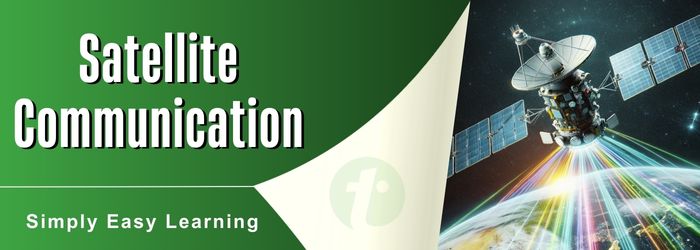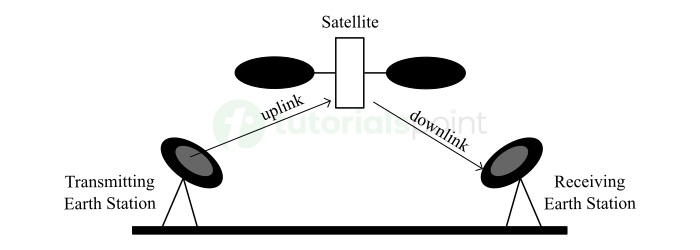
- Satellite Communication - Home
- Introduction
- Orbital Mechanics
- Kepler’s Laws
- Earth Orbit Satellites
- Look Angles & Orbital Perturbations
- Launching
- Subsystems
- AOC Subsystem
- TTCM Subsystem
- Power & Antenna Subsystems
- Transponders
- Earth Segment Subsystems
- Examples of Earth Stations
- Link Budget
- Multiple Access Techniques
- Satellite Services
- Global Positioning System

Satellite Communication Tutorial
Satellite Communication Tutorial
Satellite Communication is one of the most widely used types of communication in today's world of internet and technology. It is called satellite communication because it uses artificial satellites to establish communication links among different nodes on the Earth. Satellite communication is serving as the backbone of internet and global telecommunication services.
There are two main components of a typical satellite communication −
- Ground segment − It consists of devices and equipment on the earth such as transmission system, receiving devices, and ancillary equipment.
- Space segment − It mainly consists of communication satellites orbiting the earth.
Satellite communication takes place through uplinking and downlinking of signals between the earth's station and the satellite.

This tutorial is meant to provide the readers an overview of Satellite Communication and how it works.
What is Satellite Communication?
Satellite communication is an advanced communication technology which involves the transmission of information from one point to another by using an artificial satellite orbiting the Earth. The satellite is known as a communication satellite and it is a specially designed artificial satellite that can create a communication link to transmit signals between transmitter and receiver on the Earth.
Satellite communication is an effective communication method for transmitting information over very large distances across the globe.
In satellite communication, the artificial satellite in the orbit of the earth acts as a relay station. It receives signals from one location on the earth and retransmits them to another location on the earth. Some most common examples of satellite communication include GPS navigation and remote internet access.
Block Diagram of Satellite Communication
The following figure depicts the block diagram of the satellite communication −

It comprises the following main components −
- Transmitter (Transmitting Earth Station) − It is a device located at a point on the earth and it sends information signals to the satellite.
- Satellite Transponder (Satellite) − It is a device located on the communication satellite in the space. It receives information signals from the earth station, amplify and retransmits them to another location on the earth.
- Receiver (Receiving Earth Station) − It is the destination device in the satellite communication, located on the earth. It captures the retransmitted data from the satellite and process them.
Needs for Satellite Communication
The primary need for satellite communication is to allow the transmission of information over very long distances and in areas where physical communication mediums are not available and also difficult to establish.
The following are some key factors driving the need for satellite communication −
- To provide communication facilities in remote areas like deserts, mountainous areas, etc.
- To provide global connectivity.
- To provide services like TV and radio to a wider audience globally.
- To make navigation and location tracking easier and safer which is crucial for transportation, security, surveying operations.
- To collect data about earth's atmosphere, which is important for weather forecasting, predicting disasters, providing critical services during disasters, etc.
How Does Satellite Communication Work?
Satellite communication completes its process of information transmission between two locations on the earth in the following three simple steps −
Step 1 − First of all, a device or station on the earth sends information signals to the communication satellite in the space. This process is called uplinking.
Step 2 − The satellite transponder processes the uplinked signals to amplify them.
Step 3 − The processed signals are retransmitted by the satellite transponder back to a device or station at another location on the earth. This process is called downlinking.
Advantages of Satellite Communication
- It enables global communication and communication in remote areas.
- Satellite communication is flexible and easily scalable in terms of bandwidth requirements.
- Satellite communication is easy to integrate in a new circuit.
- The cost of satellite communication is independent of distance.
- Circuits on the earth for satellite communication are easy to install.
- Satellite communication provides a more secure communication.
- Satellite communication reduces infrastructure requirements on the earth.
Disadvantages of Satellite Communication
- The cost for developing and launching communication satellites increases the overall cost of satellite communication.
- Satellite communication is subjected to a delay, as the signals travel from earth to satellite and then back to the earth.
- Communication satellites are difficult to repair and maintain.
- Most communication satellites have an average lifespan of around 12 to 15 years.
- Satellite communication also faces the frequency congestion issues.
- Satellite communication is vulnerable to space debris and cyber threats.
- Satellite communication also have propagation and interference issues.
Applications of Satellite Communication
Satellite communication is serving as the backbone of modern internet and telecommunication services. Given below is a set of some common examples highlighting the use cases of satellite communication in real-world −
- In telecom networks, satellite communication is used for sending voice, images, videos, or other data types over very long distances.
- Satellite communication is also used in TV and radio broadcasting.
- GPS navigation, traffic management, air traffic control, etc. are dependent on the satellite communication.
- Satellite communication is also employed in military and defense operations for transmitting information securely over a wide range.
- Satellite communication is also enabling smart agriculture, weather monitoring, and disaster management.
What You Will Learn in Satellite Communication?
This tutorial is meant for explaining the fundamental concepts of satellite communication. The topics covered in the tutorial are described in the following table −
- Satellite Communication Introduction − This chapter provides an overview of satellite communication along with its needs, advantages, and applications.
- Orbital Mechanics − This section is provided to explain some important concepts of orbital mechanics of the Earth used in satellite communication.
- Keplers Laws − This chapter describes three important laws given by Kepler related to the principle of a satellite that moves around the earth.
- Earth Orbit Satellites − In this section, you will learn about different types of earth orbit satellites.
- Look Angles & Orbital Perturbations − This chapter describes two important concepts namely, look angle and orbital perturbations, in satellite communication.
- Launching − This chapter is meant for explaining the process of satellite launching and types of satellite launching vehicles.
- Satellite Communication Subsystems − In this chapter, you will learn about two important types of subsystems used in satellite communication.
- AOC Subsystem − This section explains Altitude and Orbit Control (AOC) subsystem in satellite communication.
- TTCM Subsystem − This chapter discusses about TTCM subsystem in satellite communication.
- Power and Antenna Subsystems − This chapter describes power systems and antenna subsystems used in satellite communication.
- Transponders − In this section, you will learn about the block diagram, function, and types of transponders used in satellite communication.
- Earth Segment Subsystems − This chapter is meant for explaining different subsystems of the earth segment of satellite communication.
- Examples of Earth Stations − In this chapter, you will see some real-world examples of earth stations.
- Link Budget − This chapter explains the concept of link budget and its calculation for satellite communication.
- Multiple Access Techniques − In this section, you will learn about some important types of multiple access techniques used in satellite communication.
- Satellite Communication Services − This section explains one-way and two-way satellite communication services.
- Global Positioning System − This chapter provides an overview of global positioning system and its operation.
Who Should Learn Satellite Communication?
This tutorial will be suitable for all those readers who wish to learn the fundamental concepts of satellite communication. After completing this tutorial, you will be able to learn the significance of satellite communication and its role in present scenario.
Readers belonging to any of the following categories will find this tutorial a valuable resource on satellite communication −
- Students or leaners of communication or telecommunication engineering.
- Engineers or technicians working in the field of IT, broadcasting, defense, or space technology.
Prerequisites to Learn Satellite Communication
Satellite communication is an advanced technology. Thus, the readers should have prior knowledge on some basic concepts of analog and digital communication systems, in order draw benefit from this tutorial.
Additionally, a basic understanding of physics, electromagnetic radiations, and signal processing will be an added advantage.
FAQs on Satellite Communication
In this section, we have picked up some most Frequently Asked Questions (FAQs) related to Satellite Communication, followed by their answers.
1. What are the two main components of satellite communication?
The two main components of satellite communication are −
- Ground Segment − It is the part of satellite communication that exists on the earth and consists of components like fixed or mobile transmission, reception, and ancillary devices.
- Space Segment − It exists in the earth's orbit. It consists of the communication satellite.
2. What are the three types of satellite communication?
The three main types of satellite communications are as follows −
- Telecommunication − It is defined as the exchange of information using devices like computers, telephones, mobiles, etc. over very long distances. Examples include phone calls, social media chats, etc.
- Broadcasting − It is a satellite communication that involves the distribution of audio or video content to a large audience. Examples include TV or radio broadcasting.
- Satellite Data Communication − It is a type of satellite communication that involves the exchange of any data between two points and takes place through a communication satellite.
3. What is a satellite communication device?
A satellite communication device, also known as sat-comm device, is an electronic device that allows to exchange data with other devices by using a radio link provided by earth orbiting satellite.
4. What is uplink and downlink?
Uplink and downlink are two important concepts in satellite communication −
- Uplink − In satellite communication, uplink is a communication link requested by the earth station from the satellite.
- Downlink − The communication link established by the satellite with an earth station is called downlink.
5. What is a Transponder?
In satellite communication, a transponder is an electronic device that combines a transmitter and a receiver into a single unit in a satellite, and it performs functions like signal processing, amplification, and retransmission of signals to the earth.